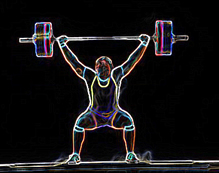Types of Exercise
There are various different types of exercise, each of which work the body in different ways. Which you choose will depend upon what your goals are, and what you enjoy doing. The Main Types of Exercise Are: • Aerobic (cardio) conditioning – for endurance
• Anaerobic (sprint) conditioning – for speed
• Flexibility
• Strength
• Power Let’s look at each in turn, and examine what they can do for you and why you might choose them.  Aerobic (Cardio) Training Aerobic (Cardio) Training
Cardio training, is developed by regularly performing activities like dancing, running, walking, swimming or cycling. As the name suggests, cardio training works the heart, lungs and circulatory system, helping them to do their job more efficiently. Improving your cardio fitness is what many people think of when they say they want to get fitter. It improves your endurance, enabling you to do simple things better – not just walking or running, but simply being busy, up on your feet and moving around. It is also an essential base for almost all sports – the ability to keep moving without effort underpins everything from football to tennis, even lower speed sports like golf.
 Anaerobic Fitness Anaerobic Fitness
Anaerobic fitness is about speed, and the ability to recover quickly from intense efforts. It has limited application in everyday life, but is a huge part of most sports, such as football, basketball or tennis. Anaerobic fitness is developed by doing interval training – repeated short intense efforts with minimal recovery periods. In addition to helping with most sports, interval training also develops aerobic (cardio fitness) and is an effective strategy for weight loss – it boosts the metabolism, so you burn more calories, 24-hours a day, seven days a week. Flexibility: Although many people ignore flexibility, it has a high degree of application for real life. Improved flexibility helps you to reach for things easily, and reduces the risk of injury. Children are naturally flexible, but as we age we lose flexibility. Indeed, loss of flexibility is a major contributor to many falls in older people. You can improve your flexibility by regularly stretching, or doing activities like yoga or Pilates.  Strength Training Strength Training
There are various forms of strength training – weights, machines, bands, body-weight exercises – all of which work your muscles to make them stronger. Depending on your goals you can focus on different aspects of strength training. These include: • Functional strength training: This is designed to help you do everyday things better, like carrying heavy groceries from the car, or climbing a sleeping child up the stairs. • Strength: Athletes like power lifters use specific protocols to maximize their strength at the expense of everything else. • Size: Body builders train differently from power lifters, emphasizing techniques that maximize muscle growth rather than absolute strength. Of course, they also get stronger, but that is not the primary goal. • Fitness: A base level of strength helps improve performance in most sports, even those, such as distance running, where you don’t want to get any bigger or heavier. In addition, increased strength will help athletes avoid many overuse injuries. • Muscular endurance: The focus for many athletes is on muscular endurance – they perform regular, high repetition exercises to condition their muscles to execute the same motion over and over again without weakening.  Power Training Power Training
Most people don’t think about training for power, but it is a vital part of training for many athletes. Power means the application of strength at speed – for an athlete such as a rugby player, it is not enough to simply be strong if you are too slow to apply that strength. Power means being able to jump, change direction, tackle, do all the things that high speed sports involve. Training for power combines a base of pure strength, but then overlays that with specific exercises, such as plyometrics, to develop the ability to employ that strength at speed. In Conclusion Combining these different types of exercise effectively will affect your success at achieving your goals. For example: • Weight loss: Although many people focus on cardio exercise for weight loss, a more effective strategy is to add the metabolism-boosting benefits of intervals (aerobic training) and weight training to really cut the fat. • General fitness: General fitness requires a balance of strength, cardio fitness and flexibility. • Sports specific fitness: Different sports have different needs – however, almost all will require you to incorporate elements from all these different types of fitness to maximize performance. Smart application of different types of exercise will dramatically increase the chances of you reaching your goals.
Back to top of Types of Exercise |